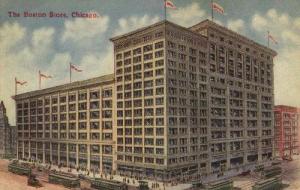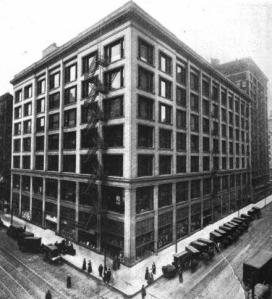Firm founded 1869, closed 1948
Loop store:
2-16 North State Street
Built 1905-1917
Architects: Holabird and Roche
Boston Store was founded by Charles Netcher, an upstart, young businessman who had moved to Chicago from Buffalo in 1869 at the age of seventeen. He initially worked as a cash boy and bundle wrapper with the Pardridge dry goods house. Shortly after the 1871 Fire, he became a partner in the outfit and soon thereafter bought out the other owners. He renamed the store as a marketing ploy, hoping the New England city’s strong reputation in merchandising would add credibility to this own establishment. Before Charles died in 1904, Boston Store expanded rapidly and soon occupied almost the entire half-block on the north side of Madison between State and Dearborn in Chicago’s Loop.
It was, however, Charles’ wife, Mollie Netcher, who guided the store through its most successful years as a major Chicago department store. In the early days of the Boston Store, she had worked as a clerk and underwear buyer. She and Charles married in 1891. After her husband’s death, Mollie skillfully transformed the old-fashioned dry-goods store into a first-rate, full-line department store, making it a leading competitor of Marshall Field’s, The Fair, and Carson Pirie Scott.

Boston Store, ca. 1917
The new Boston Store, built in phases between 1905 and 1917, was seventeen stories tall and had twenty acres of floor space. Its facilities included a post office, a Western Union office, a savings bank, a barber shop, a first-aid station, several soda fountains and restraurants, and an observation tower 325 feet above street level. A cigar factory on the seventeenth floor was capable of producing three million stogies a year. For the four thousand Chicagoans employed by the firm, there were private reading rooms, employee lunchrooms, and a full-sized employee tennis court on the roof.

Boston Store, ca. 1912
By the late 1930s, business at Boston Store had begun to decline and what had once been State Street’s second-highest-grossing department store had slipped to seventh. During those years, little effort was made to modernize the store or the way it did business. Observers criticized the store’s increasingly outdated appearance—some said it “reeked with a quaint Victorian mustiness”—and Mollie’s refusal to develop suburban outlets or break with its traditional cash-only sales policies. Boston Store closed in July of 1948. The 1917 building, however, still stands and underwent a complete renovation in 2001. The lower floors of the building now house a Sears department store.
Internet Resources
Photograph: Boston Store, female store clerks playing tennis on roof court, 8 July 1914 [Library of Congress]
Photograph: Policeman controlling crowd of pedestrians at corner of Dearborn and Madison Streets, Boston Store in background, 1926 [Library of Congress]
Photograph: Elevated view of crowds celebrating Armistice Day, standing on State and Madison Streets, 1927 [Library of Congress]
Photograph: Crowds of Christmas shoppers crossing Madison Street in the Loop community area, with Boston store on right, 1927 [Library of Congress]
Photograph: Crowds of Christmas shoppers, at the corner of State and Madison Streets, 1927 [Library of Congress]
Photograph: Crowd at State and Madison Streets, looking west on Madison from State, 1929 [Library of Congress]
Sources: Margaret Corwin, “Molly Newbury: The Merchant Princess,” Chicago History vol. 6, no. 1 (Spring 1977), 34-43.
Image sources: “The Boston Store, Chicago,” postcard, unknown publisher: #200C, n.d.; Franz Winkler, “Some Chicago Buildings,”The Architectural Record 31 (1912): 330.
